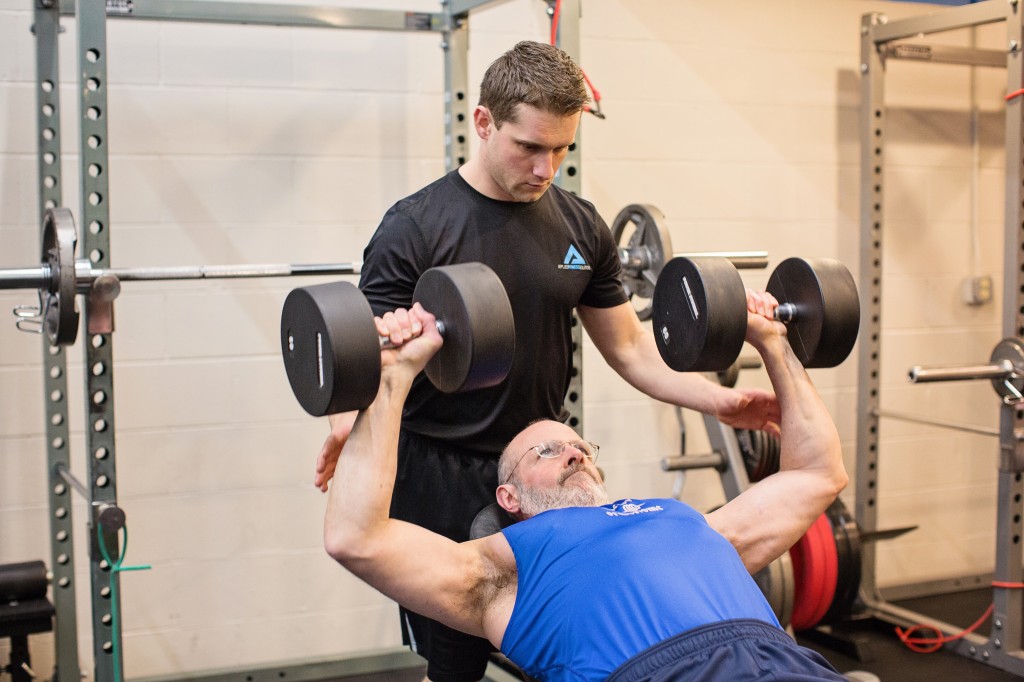The gym is a GREAT place to socialize and chat with friends. However, can too much chatting negatively affect your workout? According to new research, it just may!
The Research
Researchers in two separate studies sought to determine if focusing (intent) on a specific muscle during various exercises affected how much that specific muscle was activated.
In a study focusing on strength training (Wilson et al), researchers hooked experienced weightlifters up to sensors to detect muscle activity. Participants were directed to perform an exercise targeted at a specific back muscle under three conditions.
Study 1 (Wilson et al)
- Heavy weight with NO intent/focus: Very high loads (90% of max) with the direction to just MOVE THE WEIGHT with proper form.
- Moderate weight with intent: Moderate loads (70% of max) with the direction to focus on squeezing the specific muscle (intent).
- Heavy weight with intent: Very high loads (same as first condition) with the direction to focus on squeezing the specific muscle (intent).
In the other study (Contreras et al), participants were hooked up to the same sensors, but instead of lifting weights, they performed various body weight exercises (push-ups, back extensions, bodyweight rows, etc). Participants were instructed to use the EXACT same form when performing an exercise but vary their focus with regards to the muscle they were predominantly contracting.
Study 2 (Contreras et al)
- Squat with a quad muscle focus.
- Squat with a glute muscle focus.
- Push-up with a chest focus.
- Push-up with a tricep focus.
- Row with a back muscle focus.
- Row with a bicep focus.
The Findings
Study 1 (Wilson et al)
- Heavy weight with NO intent/focus had the LOWEST recruitment of the target muscle.
- Moderate weight with intent/focus had twice the recruitment of the targeted muscle than heavy weight with no intent.
- Heavy weight with intent/focus had about 1.5 times the recruitment of moderate weight with intent.
Study 2 (Contreras et al)
- Participants were able to significantly shift recruitment during each exercise based on which muscle they were told to focus on.
- Simply being aware of your own form may not be enough; thinking about the muscle you are trying to work also appears to be very important.
Take Home Message
Exercising with intent or focus is important at all fitness levels. For individuals trying to fine tune their physique via muscle growth, this focus may make a significant difference for trouble areas. It is also important for individuals new to exercise. Since many movements are new, improper movement patterns and imbalances in muscle activation may be present. By focusing on form and specific muscles during a given exercise, you can retrain your brain to properly recruit muscles for each exercise.
The data is clear: when you FOCUS on flexing the muscle you are trying to work, you recruit more fibers within that muscle (chest during a push-up, back muscles during a suspension row, etc). Since muscle fibers only adapt if they are recruited, it’s important that you maximize the recruitment with each repetition.
I’m not saying exercise shouldn’t be fun or social. I’m just suggesting the research indicates the more focus on the muscles you’re working will result in a more beneficial workout. What you do with this knowledge is up to you!
About the Author:
-

Michael Stack is the founder & CEO of Applied Fitness Solutions and Frontline Fitness Pros. He is a faculty lecturer for the University of Michigan’s School of Kinesiology. He is also the creator and the host of the Wellness Paradox Podcast, produced in conjunction with University of Michigan.
Michael is an exercise physiologist by training and a health entrepreneur, health educator, and fitness industry advocate by trade. He is dedicated to enhancing the standard of practice of, and advocating for, fitness and wellness professionals to ensure they become an essential constituent in the healthcare delivery system.
With a career spanning over three decades in fitness, health, and wellness Michael has a deep knowledge of exercise physiology, health/wellness coaching, lifestyle interventions to mitigate chronic disease and leadership. He is credentialed through the American College of Sports Medicine (ACSM) as an Exercise Physiologist (ACSM-EP), Exercise is Medicine practitioner (ASCM-EIM), and a Physical Activity in Public Health Specialist (ACSM-PAPHS). Michael is a National Strength & Conditioning Association (NSCA) Certified Strength & Conditioning Specialist (CSCS), and a CDC Diabetes Prevention Program (DPP) Lifestyle Coach.
Michael received his undergraduate degree from the University of Michigan’s School of Kinesiology in 2004 and is currently a Master’s of Public Health (MPH) candidate at University of Michigan, with a specific concentration in health behavior and health education.
Michael is a board of directors’ member for the Physical Activity Alliance and Michigan Fitness Clubs Association. He sits on the University of Michigan’s School of Kinesiology Alumni Board of Governors. Michael is an expert curriculum reviewer for the American College of Lifestyle Medicine. Finally, he is a member of the executive leadership team for American Heart Association’s Heart Walk.
Michael lectures nationally for several health/fitness certification and continuing educations, including; IHRSA, the Medical Fitness Association, the National Strength & Conditioning Association, and SCW Fitness.

